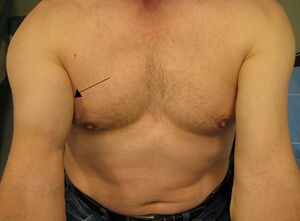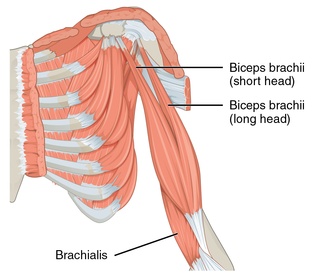Ludington’s Test
Purpose[edit | edit source]
Ludington's Test is a test that assesses for a biceps tendon rupture or a tendon pathology. Ludington’s test is a recommended position in which to observe differences in the contour and shape of the biceps [1].
Image 1: Popeye sign R upper limb, evident in biceps tendon ruptures
Technique[edit | edit source]
The test can be performed with the patient sitting with their back straight, on a chair or stool, their back to the examiner.
Procedure [3]
- The patient is instructed to clasp both hands on the top of their head, allowing the interlocking fingers to support the weight of the upper limbs.
- The examiner stands facing the patient's back in order to palpate the long head of the biceps tendon.
- The patient then alternately contracts and relaxes the biceps while the clinician palpates the tendon and muscle.
- In a complete tear, contraction is not felt on the affected side[1].
Interpretation of the results[edit | edit source]
A positive test for a rupture of the long head of the biceps is indicated by the presence of the tendon's contraction on the side not tested and the absence of the tendon's contraction on the side being tested. The inability to feel the tendon indicates a long head of biceps tendon rupture.
Rationale [edit | edit source]
Biceps tendon rupture is either a complete or partial disruption of the tendon of the biceps brachii muscle. The more common proximal ruptures account for 90% to 97% of all biceps ruptures and almost exclusively involve the long head.
Ludington’s test is a recommended position in which to observe differences in the contour and shape of the biceps. Diagnosis of complete ruptures is relatively easy; patients often come in aware of the biceps muscle retraction. Partial ruptures exist along a spectrum and can be more difficult to diagnose.[1]
Clinical Context and considerations[edit | edit source]
The biceps brachii muscle is involved in supination and flexion of the forearm.
- The majority of biceps tendon ruptures occur at the proximal insertion and almost always involve the long head.
- A thorough physical examination of bilateral upper extremities should be carried out to assess for deformity, neurovascular impairment and, asymmetry.[6]
- The examiner should also assess the shoulder and elbow range of motion in addition to testing the upper extremity strength, especially of the biceps muscle itself.[7]
Related Tests [8][edit | edit source]
- Heuter's Sign
- Gilchrest's Sign
- Lippman's Test
References[edit | edit source]
- ↑ 1.0 1.1 1.2 Musculoskeletal key Biceps tendon rupture Available:https://musculoskeletalkey.com/biceps-tendon-rupture/ (accessed 11.1.2022)
- ↑ Magee. Orthopedic Physical Assessment. 4th Ed. 2002.
- ↑ 3.0 3.1 Ludington's Test. Available from: https://www.thestudentphysicaltherapist.com/ludingtons-test.html (Accessed, 26 February 2021)
- ↑ The Physio Channel. Ludington's Bicep & Shoulder Test Positive or Negative? Available from: http://www.youtube.com/watch?v=23sTljGyOXA [last accessed 5/3/2021]
- ↑ Ccedseminars. Ludington's Test. Available from: https://www.youtube.com/watch?v=LGlSDlFLUA0 [last accessed 5/3/2021]
- ↑ Elser F, Braun S, Dewing CB, Giphart JE, Millett PJ. Anatomy, function, injuries, and treatment of the long head of the biceps brachii tendon. Arthroscopy: The Journal of Arthroscopic & Related Surgery 2011; 27(4): 581-92
- ↑ Biceps Tendon Rupture. Available from: https://epmonthly.com/article/bicep-tendon-rupture/ ( Accessed, 05/03/2021)
- ↑ Hattam P, Smeatham A. Special Tests in Musculoskeletal Examination. Edinburgh: Churchill Livingstone, 2010








